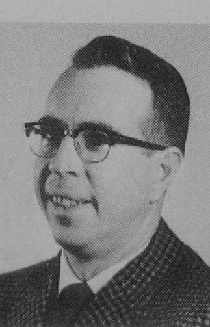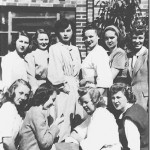 by Jack C. Holland
by Jack C. Holland
Written in Winter 2011-12
Clinical Laboratory science began to develop in the 1920s and 1930s. Most of the work was done by pathologists or physicians in private office practice. Eventually the office nurse would find this to be part of her duties. In the 1930s the degree of Medical Technology was instituted to separate the analytical needs of the profession from the hands on nursing. World War II had a profound effect the whole medical field; money was made available for better medical instrumentation and all medical training was expanded. At the end of the war in 1946 hospitals were developing large, well equipped pathology laboratories and the new wartime doctors were trained to use them. The new degree in Medical Technology was appealing to both men and women who found it satisfying to help people with scientific analysis rather than the hands on work done by other medical professionals.
The Chemistry Department at Michigan Tech became involved with this new degree at the end of WW II. At first the students were truly chemistry majors who were sent to a hospital laboratory for a year of internship during their degree. The hospitals provided them with classroom instruction and hands on training in Clinical Chemistry, Immunology, Microbiology, and many other aspects of this new science. These courses transferred into Michigan Tech and were accepted as part of their degree. At first this bachelor’s degree became labeled General Science and it wasn’t until 1958 that its name was formally changed to Medical Technology. The name of the degree was then changed again in 1995 to Clinical Laboratory Science because the term “Medical Technology” sounded like it was the same as the service provided by ambulance personnel rather than scientific analysis. The original degree was initiated on the Michigan Tech campus in 1945 with Dr. Kendall acting as the advisor for these students in the Department of Chemistry. The first class of two students graduated in 1949.
In 1949 Dr. San Clemente (Chemistry Department) started the first on-campus course in clinical laboratory science. It was called Blood and Urine Analysis. Dr. San Clemente was director of a military chemical/ microbiological laboratory during WW II and taught the science with great enthusiasm. (He was also responsible for the establishment of K Day in the fall term.)

Dr. Horton took over the Med Tech program from Dr. San Clemente but it remained in the Chemistry Department. During this period very little development in the degree took place.
In 1963 Dr Spain, a biochemist, was appointed Head of the newly created Biological Sciences Department and the
Medical Technology degree came under his direction. In 1966 Dr. Spain appointed Dr. Holland as adviser and finally Director of the Clinical Laboratory Sciences degree. Dr. Holland came to Michigan Tech with 14 years of laboratory experience in hospital and clinical laboratories and he was Board Certified in Clinical Chemistry. His first stage of development introduced a course in Clinical Chemistry in 1966 and then new ones covering Hematology, Urology, and Serology. A seminar series on medicine was popular from its inception. Besides these new courses the students were now required to take analytical chemistry and organic chemistry as well as freshman chemistry from the chemistry degree program. They responded well to these new academic requirements and enrollment increased as new medically oriented courses were instituted. However, many of these students came forward expressing a need to specialize.
The specialized curricula were easy to develop. A professor of business administration who was a hospital administrator with a PhD, James Gale, provided courses in the business curriculum, and set up special courses of medical interest for the students. This was the most popular specialty developed. Because of it, Michigan Tech gained a power base in hospitals throughout the country, since many of these students became laboratory and hospital managers.
The chemistry option didn’t need any new faculty. The students were required to take physical chemistry and a few other special courses, so that with their Medical Technology degree they could go directly into graduate school in Chemistry without having any academic deficiencies. Not many students followed this pathway, but some went on to work as clinical chemists in hospitals and researchers in pharmaceutical companies.
The Research Option was very popular. In this pathway the students took courses on research planning, statistical methods, and specific courses in the area that they wished to specialize in. A faculty position in Microbiology, Dr Eunice Carlson, was added in the Biological Sciences Department. This faculty member added courses in Medical Microbiology, directed research in this area for graduate students, and had the undergraduates assist in those studies. This indoctrinated them into research. These students rarely stayed in hospitals. The big medically oriented companies hired them as fast as they graduated.
Teaching was also a very popular specialty. Here the students, under the direction of Dr. Calvin Gale, got a Clinical Laboratory Science degree and a Michigan Secondary School Teaching Certificate at the same time. They would student teach in a Michigan High School before graduation. If they went on to internship, it was done after graduation. These people could teach math, chemistry, or biology in high school. Because of their medical background they were very popular teachers who could answer the hard questions on health that the high school students were interested in. Most of those who went on into internship, and practiced medical technology eventually became educational coordinators in hospitals.
The students that specialized in computer science in the 1980’s with Dr. Lowther gained choice positions in large hospitals and medical related industries like insurance companies. There were plenty of courses for them on campus. Nobody had more enthusiasm for their option than the computer specialists.
A small number of students came forward to specialize in the problems of Social Science. These students, working under Dr. Melton, were a dedicated few who seemed to be the most sensitive to the problems of the patients. They all had interesting things to say about their backgrounds. Either they, or their family, had suffered from some devastating medical problem. They were determined to help others. As medical technologists they understood the inner workings of hospital laboratories and the problems generated by the hospitals themselves. There weren’t many of these people, but they were in great demand when they graduated.

To complete the curricula for all of these students, three new faculty members were hired who were medical technologists. They were Alice Soldan, Dr. David Nevalinen, and Debbie Gregg. These faculty members now covered all of the subjects that the Medical Technology degree demanded to complete the curriculum. Responding to the Clinical Laboratory Science degree requirements at Michigan Tech, pathologists proposed that the year of internship should now be described it as the “Clinical Year of Education.” This began to give the internship a postgraduate status.

Alice Soldan was the first faculty member the first-year students came in contact with. She wrote her home phone number on the blackboard, and told them to call her if they got into difficulty. She developed medically oriented courses for freshmen, so they didn’t get frustrated with just pure science in that very difficult year. Alice remains director of the Clinical Laboratory Science degree to this day.
